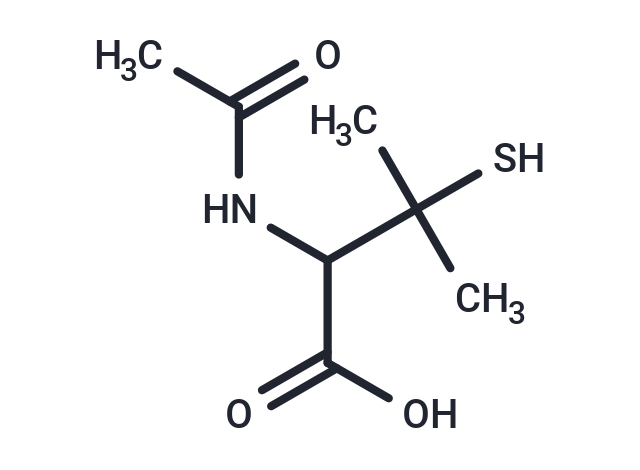 Your shopping cart is currently empty
Your shopping cart is currently empty

N-Acetyl-DL-penicillamine is a chelating agent.1,2,3It inhibits the binding of methyl mercury to isolated human erythrocytes by 50% and removes 50% of methyl mercury ions from methyl mercury-loaded blood cells when used at a concentration of 1 mM.1,2N-Acetyl-DL-penicillamine (3 mmol/kg per day, p.o.) reduces the biological half-life of mercury and decreases liver, kidney, brain, and blood mercury levels, as well as increases urinary excretion of mercury in a concentration-dependent manner, in mice when administered following injection of methyl mercuric chloride. It decreases mercuric chloride-induced mortality in mice when administered orally at a dose of 1.6 mmol/kg.3N-Acetyl-DL-penicillamine is also an analog of SNAP that does not generate nitric oxide and has been used as a negative control in experiments using SNAP.4,5

| Pack Size | Price | USA Warehouse | Global Warehouse | Quantity |
|---|---|---|---|---|
| 500 mg | $548 | 35 days | 35 days | |
| 5 g | $3,630 | 35 days | 35 days |
| Description | N-Acetyl-DL-penicillamine is a chelating agent.1,2,3It inhibits the binding of methyl mercury to isolated human erythrocytes by 50% and removes 50% of methyl mercury ions from methyl mercury-loaded blood cells when used at a concentration of 1 mM.1,2N-Acetyl-DL-penicillamine (3 mmol/kg per day, p.o.) reduces the biological half-life of mercury and decreases liver, kidney, brain, and blood mercury levels, as well as increases urinary excretion of mercury in a concentration-dependent manner, in mice when administered following injection of methyl mercuric chloride. It decreases mercuric chloride-induced mortality in mice when administered orally at a dose of 1.6 mmol/kg.3N-Acetyl-DL-penicillamine is also an analog of SNAP that does not generate nitric oxide and has been used as a negative control in experiments using SNAP.4,5 |
| Molecular Weight | 191.248 |
| Formula | C7H13NO3S |
| Cas No. | 59-53-0 |
| Smiles | CC(=O)NC(C(O)=O)C(C)(C)S |
| Storage | Powder: -20°C for 3 years | In solvent: -80°C for 1 year |
| Solubility Information | DMF: 30 mg/mL (156.86 mM), Sonication is recommended. DMSO:PBS (pH 7.2) (1:7): 0.12 mg/mL (0.63 mM), Sonication is recommended. DMSO: 30 mg/mL (156.86 mM), Sonication is recommended. Ethanol: 5 mg/mL (26.14 mM), Sonication is recommended. |
| Size | Quantity | Unit Price | Amount | Operation |
|---|

Copyright © 2015-2026 TargetMol Chemicals Inc. All Rights Reserved.